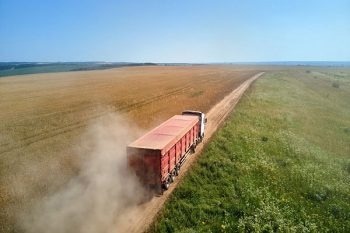Though natural fertilizers made from treated sewage sludge are used to reintroduce nutrients onto agricultural fields, they bring along microplastic pollutants too. And according to a small-scale study published in ACS’ Environmental Science & Technology Letters, more plastic particles get picked up by the wind than once thought. Researchers have discovered that the microplastics are released from fields more easily than similarly sized dust particles, becoming airborne from even a slight breeze.
 Microplastics on agricultural fields are picked up and spread by the wind more easily than soil or dust particles. Bilanol/Shutterstock.com
Microplastics on agricultural fields are picked up and spread by the wind more easily than soil or dust particles. Bilanol/Shutterstock.com
Microplastics, or small bits of plastic less than 5 millimeters long, have appeared everywhere from clouds to heart tissues. And with these plastics’ increasing prevalence in people and water supplies, they’ve also been found in sewage and wastewater. Though sewage solids might not immediately seem like a useful product, after treatment they can form “biosolids,” which are applied to agricultural soils as a natural, renewable source of fertilizer. According to estimates by the U.S. Environmental Protection Agency, over 2 million dry metric tons of biosolids — roughly half of the total amount collected by wastewater treatment plants — are applied to land each year. As a result, microplastics in these biosolids have the chance to reenter the environment. Because the plastics could carry other pollutants from the wastewater they originated from, they can be potentially dangerous when inhaled. So, Sanjay Mohanty and colleagues wanted to investigate how wind could pick up and transport microplastic particles from biosolid-treated agricultural fields.
The team analyzed airborne microplastics in wind-blown sediments that were gathered during wind-tunnel experiments on two plots of biosolid-treated land in rural Washington state. The researchers discovered that these wind-blown sediments contained higher concentrations of microplastics than either the biosolids or the source soil itself. This enrichment effect is caused by the plastic particles being less dense than soil minerals, such as quartz, and less “sticky” — they’re not trapped as easily by moisture as the soil minerals are. As a result, microplastics can be picked up by a breeze more easily than soil minerals, and winds that might not be strong enough to kick up dust could still be introducing microplastics into the air.
The researchers say that previous models did not take this sticky effect and other unique properties of microplastics into account when estimating emissions from treated fields. Therefore, these older models are likely to underestimate the actual amount of plastic particles released into the air. Calculations by Mohanty and colleagues indicate that microplastics may be emitted from barren agricultural fields from nearly two and a half times more wind events than previously estimated. The researchers say this work highlights an underappreciated way that microplastics could become airborne.
The authors acknowledge funding from the National Science Foundation Graduate Research Fellowship Program and the McPike Zima Charitable Foundation.